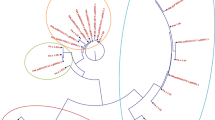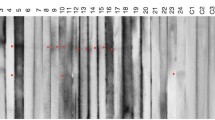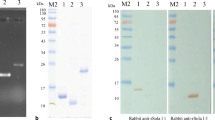Abstract
Pathogenesis-related protein-10 (PR10) is a ubiquitous small plant protein induced by microbial pathogens and abiotic stress that adversely contributes to the allergenic potency of many fruits and vegetables, including carrot. In this plant, two highly similar genes encoding PR10 isoforms have been isolated and designated as allergen Dau c 1.01 and Dau c 1.02. The aim of the study was to generate PR10-reduced hypoallergenic carrots by silencing either one of these genes in transgenic carrots by means of RNA interference (RNAi). The efficiency of gene silencing by stably expressed hairpin RNA (hnRNA) was documented by means of quantitative RT-PCR (qPCR) and immunoblotting. Quantification of the residual protein revealed that PR10 accumulation was strongly decreased compared with untransformed controls. Treatment of carrot plants with the PR protein-inducing chemical salicylic acid resulted in an increase of PR10 isoforms only in wild-type but not in Dau c 1-silenced mutants. The decrease of the allergenic potential in Dau c 1-silenced plants was sufficient to cause a reduced allergenic reactivity in patients with carrot allergy, as determined with skin prick tests (SPT). However, simultaneous silencing of multiple allergens will be required to design hypoallergenic carrots for the market. Our findings demonstrate the feasibility of creating low-allergenic food by using RNAi. This constitutes a reasonable approach to allergen avoidance.




Similar content being viewed by others
Abbreviations
- Qpcr:
-
Quantitative RT-PCR
- PR:
-
Pathogenesis-related
- RNAi:
-
RNA interference
- SPT:
-
Skin prick test
- WT:
-
Wild-type
References
Ballmer-Weber BK, Wüthrich B, Wangorsch A, Fötisch K, Altmann F, Vieths S (2001) Carrot allergy: double-blinded, placebo-controlled food challenge and identification of allergens. J Allergy Clin Immunol 108:301–307
Ballmer-Weber BK, Wangorsch A, Bohlen B, Kaul S, Kündig T, Fötisch K, van Ree R, Vieths S (2005) Component-resolved in vitro diagnosis in carrot allergy: does the use of recombinant carrot allergens improve the reliability of the diagnostic procedure? Clin Exp Allergy 35:970–978
Bohle B, Radakovics A, Lüttkopf D, Jahn-Schmid B, Vieths S, Ebner C (2005) Characterization of the T cell response to the major hazelnut allergen, Cor a 1.04: evidence for a relevant T cell epitope not cross-reactive with homologous pollen allergens. Clin Exp Allergy 35:1392–1399
Bradford MM (1976) A rapid and sensitive method for the quantitation of microgram quantities of protein utilizing the principle of protein-dye binding. Anal Biochem 72:248–254
Chen ZY, Brown RL, Damann KE, Cleveland TE (2010) PR10 expression in maize and its effect on host resistance against Aspergillus flavus infection and aflatoxin production. Molec Plant Pathol 11:69–81
Christensen AB, Cho BH, Næsby M, Gregersen PL, Brandt J, Madriz-Ordeñana K, Collinge D, Thordal-Christensen H (2002) The molecular characterization of two barley proteins establishes the novel PR-17 family of pathogenesis-related proteins. Molec Plant Pathol 3:135–144
Colditz F, Niehaus K, Krajinski F (2007) Silencing of PR-10-like proteins in Medicago truncatula results in an antagonistic induction of other PR proteins and in an increased tolerance upon infection with the oomycete Aphanomyces euteiches. Planta 226:57–71
Dreborg S (1989) EAACI: skin test for diagnosis of IgE-mediated allergy. Allergy 44(Suppl 10):31–37
Gamborg OL, Miller RA, Ojimai K (1968) Nutrient requirements of suspension cultures of soybean root cells. Exp Cell Res 50:151–158
Gilissen LJWJ, Bolhaar STHP, Matos CI, Rouwendal GJA, Boone MJ, Krens FA, Zuidmeer L, van Leeuwen A, Akkerdaas J, Hoffmann-Sommergruber K, Knulst AC, Bosch DW, van de Weg E, van Ree R, Gilissen LJW (2005) Silencing the major apple allergen Mal d 1 by using the RNA interference approach. J Allergy Clin Immunol 115:364–369
Herman EM (2003) Genetic modification removes an immunodominant allergen from soybean. Plant Physiol 132:36–43
Hoffmann-Sommergruber K, O′Riordain G, Ahorn H, Ebner C, Laimer da Camara Machando M, Pühringer H, Scheiner O, Breiteneder H (1999) Molecular characterization of Dau c 1, the Bet v 1 homologous protein from carrot and its cross-reactivity with Bet v 1 and Api g 1. Clin Exp Allergy 29:840–847
Hompes S, Scherer K, Köhli A, Rueff F, Mahler V, Lange L, Treudler R, Rietschel E, Szepfalusi Z, Lang R, Rabe U, Reese T, Beyer K, Schwerk N, Worm M (2010) Nahrungsmittel-Anaphylaxie: Daten aus dem Anaphylaxie-Register. Allergo J (in press)
Imani J, Berting A, Nitsche S, Schäfer S, Gerlich WH, Neumann KH (2002) The integration of a major hepatitis B virus gene into cell-cycle synchronized carrot cell suspension cultures and its expression in regenerated carrot plants. Plant Cell Tiss Org Cult 71:157–164
Jahn-Schmid B, Radakovics A, Lüttkopf D, Scheurer S, Vieths S, Ebner C, Bohle B (2005) Bet v1142–156 is the dominant T-cell epitope of the major birch pollen allergen and important for cross-reactivity with Bet v 1–related food Allergens. J Allergy Clin Immunol 116:213–219
Karamloo F, Wangorsch A, Kasahara H (2001) Phenylcoumaran benzylic ether and isoflavonoid reductases are a new class of cross-reactive allergens in birch pollen, fruits and vegetables. Eur J Biochem 268:5310–5320
Karimi M, Inze D, Depicker A (2002) GATEWAY vectors for Agrobacterium-mediated plant transformation. Trends Plant Sci 7:193–195
Kogel KH, Langen G (2005) Induced disease resistance and gene expression in cereals. Cell Microbiol 7:1555–1564
Lazo GR, Stein PA, Ludwig RA (1991) A DNA transformation-competent Arabidopsis genomic library in Agrobacterium. Nat Biotechnol 9:963–967
Le LQ, Lorenz Y, Scheurer S, Foetisch K, Enrique E, Bartra J, Biemelt S, Vieths S, Sonnewald U (2006) Design of tomato fruits with reduced allergenicity by ds-RNAi mediated inhibition of ns-LTP (Lyc e 3) expression. J Plant Biotechnol 4:231–242
Liu JJ, Ekramoddoullah AKM (2006) The family 10 of plant pathogenesis-related proteins: their structure, regulation, and function in response to biotic and abiotic stresses. Physiol Mol Plant Pathol 68:3–13
Marknell DeWitt A, Niederberger V, Lehtonen P, Spitzauer S, Sperr WR, Valent P, Valenta R, Lidholm J (2002) Molecular and immunological characterization of a novel timothy grass (Phleum pratense) pollen allergen, Phl p 11. Clin Exp Allergy 32:1329–1340
Nakamura R, Matsuda T (1996) Rice allergenic protein and molecular-genetic approach for hypoallergenic rice. Biosci Biotechnol Biochem 60:1215–1221
Ossowski S, Schwab R, Weigel D (2008) Gene silencing in plants using artificial MicroRNAs and other small RNAs. Plant J 53:674–690
Tada Y (1996) Reduction of 14–16 kDa allergenic proteins in transgenic rice plants by antisense gene. FEBS Lett 391:341–345
van Loon LC, Pieterse CM (2006) Significance of inducible defense-related proteins in infected plants. Annu Rev Phytopathol 44:135–162
Vieths S, Scheurer S, Ballmer-Weber B (2002) Current understanding of cross-reactivity of food allergens and pollen. In: Genetically engineered foods: assessing potential allergenicity. Ann N Y Acad Sci 964, pp 47–68
Xie YR, Chen ZY, Brown RL, Bhatnagar D (2010) Expression and functional characterization of two pathogenesis-related protein10 genes from Zea mays. J Plant Physiol 167:121–130
Acknowledgments
We thank Dr. Jonas Lidholm and Asa Marknell DeWitt (Phadia AB, Uppsala Sweden) for providing the experimental ImmunoCAPs. The work was supported by grants Ko 1208/18-1, Mahler Ma 1997/3-1, So 300/13-1 and Vi 165/6-1 from the German Research Foundation (DFG).
Author information
Authors and Affiliations
Corresponding author
Additional information
Susanna Peters and Jafargholi Imani contributed equally.
Electronic supplementary material
Below is the link to the electronic supplementary material.
Rights and permissions
About this article
Cite this article
Peters, S., Imani, J., Mahler, V. et al. Dau c 1.01 and Dau c 1.02-silenced transgenic carrot plants show reduced allergenicity to patients with carrot allergy. Transgenic Res 20, 547–556 (2011). https://doi.org/10.1007/s11248-010-9435-0
Received:
Accepted:
Published:
Issue Date:
DOI: https://doi.org/10.1007/s11248-010-9435-0




